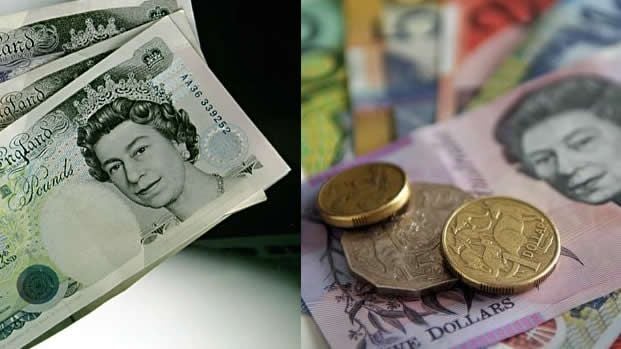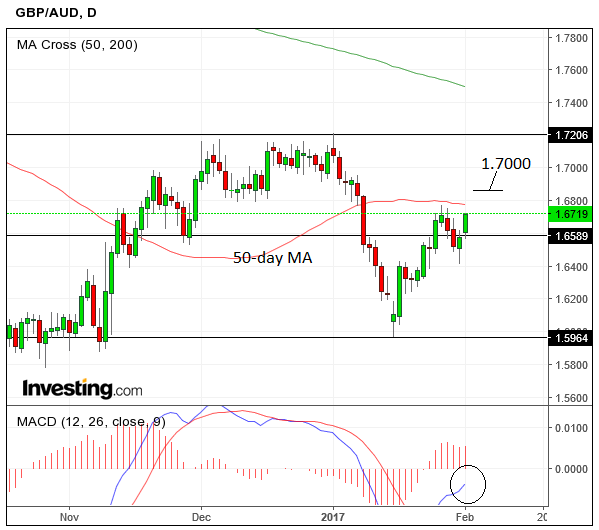The GBP/AUD: 'Strong Uptrend' Forecast to Extend

The GBP/AUD conversion maintains a positive bias and our studies suggest further gains from here are possible.
The first day of February saw the GBP/AUD move sharply higher as Sterling bulls re-entered the market.
Whilst GBP/AUD is still below the 1.6780 highs, the short-term trend higher nevertheless looks to be resuming.
Although the exchange rate looks poised to continue higher, the 50-day moving average situated at 1.6779 could provide some resistance to further gains.
Moving averages are not just indicators of the trend but also act as dynamic support and resistance levels as market players tend to enter and exit the market at these levels.
For confirmation of a continuation higher we would ideally like to see a clearance well above this level and the 1.6780 highs.
A break above 1.6850 would probably confirm a clearance above the moving average and see a high chance of a continuation up to a target at 1.7000.Analysts turn bearish the Aussie.
Analysts turn bearish the Aussie
Recent analysis of the Australian Dollar has tended to be negative about its outlook.
The lower-than-expected inflation print for Australia in the fourth quarter raised concerns about the outlook for the Australian economy given the general trend to higher inflation globally since Trump’s election.
Expectations are now increasing that the Reserve Bank of Australia (RBA) may cut interest rates at some point later in 2017.
The impact of such a move or expectations of a cut will be keenly felt by the Aussie which gains much of its value from the Carry trade, of which it has been one of the leading beneficiaries recently, especially when rates were extremely low amongst G10 counterparts.
The Carry trade is a popular investment strategy which involves investors borrowing a currency from a low inflation rate domicile and investing it in a high interest yielding currency. The profit is the difference.
China Could Weigh
Another reason analysts are wary of the Australian Dollar's prospects in 2017 are lingering concerns of a slowdown in the Chinese economy which is a major purchaser of Australian commodities and therefore contributor to the Australian economy.
Donald Trump’s protectionist policies and their potentially negative impact on China is one reason why the economy is vulnerable to a slowdown.
The weakening Renminbi is another cause for concern as it will make Aussie exports increasingly unaffordable to Chinese buyers.
The weaker Chinese currency has also led the Peoples Bank of China (PBoC) to tighten its monetary policy, by increasing interest rates, which in turn has narrowed credit channels.
There is a direct relationship between the amount of credit available in China and the value of the Aussie Dollar since more ample credit leads Chinese companies to buy more Australian resource and commodity exports, which leads to higher demand for the Australian currency.
Chinese data on Wednesday came out marginally higher than expected at 51.3 instead of the 51.2 forecast, but lower than the 51.4 previously.
Caixin Manufacturing PMI, out on Friday is expected to come out at 51.8, slightly lower than the 51.9 previously, and could be a factor in Aussie valuations at the end of the week.
Sterling Centre Stage on Thursday
The most significant event for the Pound in the remaining half of the week is the Bank of England (BOE) rate meeting on Thursday.
There is a chance of Sterling appreciating as the BOE will probably revise up their forecasts for growth and inflation, according to Capital Economics’ Scott Bowman.
Recent positive data showing strong consumption and low unemployment means the BOE has more room to tackle rising inflation caused by the week pound.
This could lead to heightened expectations of the BOE raising interest rates, and Thursday is likely to show, at the very least, a change of stance from neutral to hawkish, which would propel Sterling higher.
“We like buying pounds into the Quarterly Inflation Report, especially as it dips toward 1.25 with a target of 1.27/1.28,” says BK Asset Management’s Kathy Lien.
Other analysts, however, see Sterling pushed lower by the increasing reality of a “Hard” Brexit regardless of Parliament’s involvement.
“It's strange to see GBP performing so well when the path towards a 'hard' Brexit remains firmly on the table; strategically, we remain bearish on GBP/USD and look for fresh catalysts (namely dollar strength) to see a short-term move back towards the 1.24 level,” said ING’s Patel.
UK PMI data, out on Wednesday, Thursday, and Friday, also deserves a mention.
Manufacturing PMI has already been released on Wednesday and came out lower at 55.9 as forecast, from 56.1 previously.
Construction and Services PMI’s are released respectively at 9.30, with Manufacturing expected to pull-back a basis point to 56.0, Construction forecast to 53.8 from 54.2 and Services to 55.8 from 56.2.
Pound to Australian Dollar: Midweeek Review, Rising Strongly After Correction






